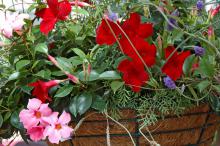Information Possibly Outdated
The information presented on this page was originally released on April 17, 2008. It may not be outdated, but please search our site for more current information. If you plan to quote or reference this information in a publication, please check with the Extension specialist or author before proceeding.
Sun Parasols mandevilla blooms until frost arrives
By Norman Winter
MSU Horticulturist
Central Mississippi Research & Extension Center
Many gardeners want plants that will bloom right up until frost. Some past options have been New Gold lantana or the award-winning Diamond Frost euphorbia, and now gardeners can add Sun Parasols mandevilla to that list of summer-long bloomers.
Mandevillas also have the common name Brazilian jasmine. As that name suggests, mandevilla is from Brazil, but you will think it is one of the locals when you see it at the garden center. It is related to the allamanda vine, with its yellow, bell-shaped flowers, and to plumeria, the flowers used to make leis in Hawaii.
For years, the most popular variety of mandevilla has been Alice du Pont, which produces loads of large, pink, bell-shaped flowers on a vigorous vine. The dark, glossy leaves have a leathery feel. If you have seen a big, pink-flowered vine climbing up a neighbor's mailbox, this was probably the plant.
This year, however, look for the new Suntory mandevillas by the name of Sun Parasol. The Sun Parasol has the most deeply saturated red on the market, and everyone has fallen head over heels for its velvety flowers.
The Sun Parasols line has nine varieties, including Dark Red, Crimson and Giant Crimson. You also will find Pink, Cream Pink and Giant Pink. Those of you who like white will appreciate the Sun Parasols Giant White. The other two varieties are Sun Parasols Pretty Crimson and Sun Parasols Pretty Pink. They are somewhat compact because of branching and shorter internodes.
As with almost every other plant I write about, mandevilla will die if it does not have well-drained soil. For best flowering, mandevillas need to receive at least six to eight hours of sunlight a day.
Since they are vigorous vine and flower producers, mandevillas need small doses of fertilizer every two to three weeks. Use a balanced, water-soluble fertilizer or time-released granules. Maintain moisture during the hot, dry times of the summer. A prolonged period without water may prove fatal to the plant.
Try growing mandevilla in a large hanging basket and let it climb the long chains. A lime-green sweet potato vine flowing out of the basket will help show off the mandevilla. Try intertwining mandevilla with the iridescent blue-flowered Blue Glory thunbergia.
The Sun Parasols mandevilla is a must for lattice structures around the house. Its ability to climb 12 to 15 feet and bloom until fall make mandevilla a champion. As it is a tropical plant from Brazil, treat mandevilla like an annual or give it winter protection.
Before bringing mandevilla indoors, know your goal is simply to hold the plant until the next planting season. It will probably drop leaves because of lower light conditions.
In the spring, you can repot or plant it in the landscape and resume the fertilization program. Tropical plants are some of the best options for plants with five or six months of continuous bloom. Mandevillas, like the Sun Parasols, are at the top of that list.




